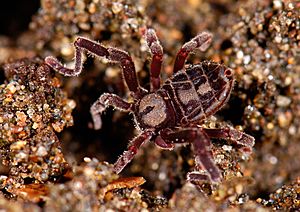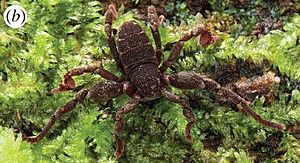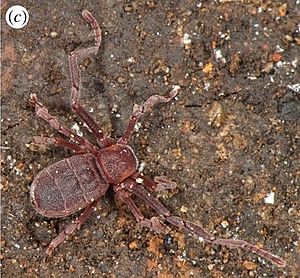Ricinulei facts for kids
Quick facts for kids Ricinulei |
|
|---|---|
 |
|
| Cryptocellus goodnighti | |
| Scientific classification |
|
| Kingdom: | Animalia |
| Phylum: | Arthropoda |
| Subphylum: | Chelicerata |
| Class: | Arachnida |
| Order: | Ricinulei Thorell, 1876 |
| Family: | Ricinoididae Ewing, 1929 |
| Exant genera | |
For fossil genera, see text |
|
Ricinulei are a small group of arachnids. Arachnids include spiders, scorpions, and ticks. Like most arachnids, ricinuleids are predators. This means they hunt and eat small arthropods, which are creatures like insects and spiders.
Today, you can find ricinuleids in west-central Africa (the Ricinoides type) and in the Americas (like Cryptocellus and Pseudocellus). They live as far north as Texas. As of 2021, scientists have found 91 different kinds of ricinuleids around the world. All of them belong to one family called Ricinoididae. Because they are not well-known, they don't have a common name. Sometimes, scientists call them hooded tickspiders.
Besides the living types, we have also found fossil species. These ancient ricinuleids lived during the upper Carboniferous period in Europe and North America. Others have been found in Cretaceous Burmese amber.
Contents
What Do Ricinulei Look Like?
Ricinulei are usually about 5 to 10 millimeters (0.2 to 0.4 inches) long. This is about the size of a small pea. The largest ricinulei ever found was a fossil called Curculioides bohemondi. It lived a very long time ago and was about 21.77 mm (0.86 inches) long.
Their outer shell, called a cuticle or exoskeleton, is very thick. Their most special feature is a "hood" called a cucullus. This hood can be lifted up or lowered down over their head. When it's lowered, it covers their mouth and mouthparts. Living ricinuleids do not have eyes. However, fossil ricinuleids had two pairs of eyes. Even today, living species have parts of their cuticle that can sense light where eyes used to be.
Their heavy back part, called the abdomen or opisthosoma, connects to the front part (prosoma) with a narrow "waist." The abdomen has a special way of connecting to the front part. The front edge of the abdomen fits into a fold at the back of the prosoma. The top of the abdomen is divided into several large plates.
Legs and Mouthparts
The mouthparts, called chelicerae, have two parts that form a small pincer. These pincers help them grab food. They also have special sensors near their mouth to "taste" their food. The mouthparts can be pulled back and are usually hidden under the hood when the ricinuleid is resting.
Ricinuleids have complex pedipalps. These are like small arms near their mouth. They use them to hold food. They also have many sensors on their pedipalps. These act like "short-range" feelers. The pedipalps end in small pincers. These pincers are much smaller than those found on scorpions or pseudoscorpions.
Like some harvestmen, the second pair of legs on ricinuleids is the longest. They use these long legs to feel their way around, almost like antennae. If the pedipalps are for short-range sensing, these second legs are for long-range sensing. The tips of their first and second legs have different sensors than their third and fourth legs. Male ricinuleids have a special third pair of legs. These legs are shaped in unique ways and are used for reproduction. Scientists use the shape of these legs to tell different male species apart.
How Ricinulei Breathe
Ricinuleids breathe using special tubes called trachea. Air enters through a single pair of small holes on their front body part. Some ricinuleids, like one type found in Brazil, have a special skin structure called a plastron. This might help them stay dry and breathe even if they get covered in water.
Ricinulei Life and Habits
Ricinuleids live in the leaf litter on the ground of rainforests. They also live in caves. They use their long second pair of legs to search for prey. They eat other small invertebrates, but we don't know much about their exact diet.
We also don't know much about how they find mates and reproduce. However, male ricinuleids use their special third pair of legs to pass a packet of sperm to the female. The mother carries her eggs under her hood. When the young hatch, they have six legs. Later, they molt (shed their skin) and grow into their eight-legged adult forms. Having six-legged young is something they share with Acari (mites and ticks).
Recent studies show that ricinuleids are active at night. They also have interesting behaviors, like interacting with other ricinuleids in ways that are not just about mating. Ricinuleids are often found gathered in large groups, but scientists are still trying to figure out why.
Ancient Ricinulei: The Fossil Record
Ricinulei are special among arachnids because the very first one found was a fossil. It was described in 1837 by a geologist named William Buckland. He thought it was a beetle at first! More fossil species were found later by other scientists.
Most of the fossil ricinuleids (15 out of 20) come from the late Carboniferous period. These were found in coal beds in Europe and North America. Scientists have put these fossils into a separate group called Palaeoricinulei. These fossils are divided into four families.
Some Carboniferous ricinuleids were much bigger than modern ones, with bodies up to 24 mm (0.94 inches) long. Many of them also had eyes, unlike the blind ricinuleids of today. It's likely they lived on the surface, not hidden away like modern ricinuleids. Fossils from the Cretaceous Burmese amber are thought to have lived in trees and hunted on bark.
Types of Ricinulei
As of September 2022, the World Ricinulei Catalog lists the following eleven types (genera):
- Cryptocellus Westwood, 1874
- Pseudocellus Platnick, 1980
- Ricinoides Ewing, 1929
- †Amarixys Selden, 1992
- †Curculioides Buckland, 1837
- †Hirsutisoma Wunderlich, 2017
- †Monooculricinuleidae Wunderlich, 2017
- †Poliochera Scudder, 1884
- †Primoricinuleus Wunderlich, 2015
- †Sigillaricinuleus Wunderlich, 2022
- †Terpsicroton Selden, 1992
See also
 In Spanish: Ricinúlidos o garrapatas encapuchadas para niños
In Spanish: Ricinúlidos o garrapatas encapuchadas para niños




